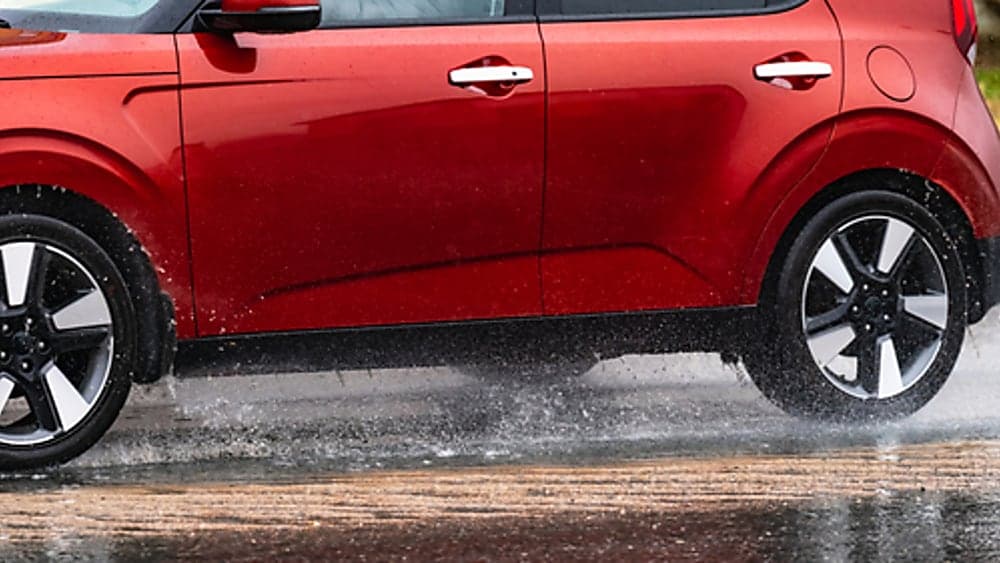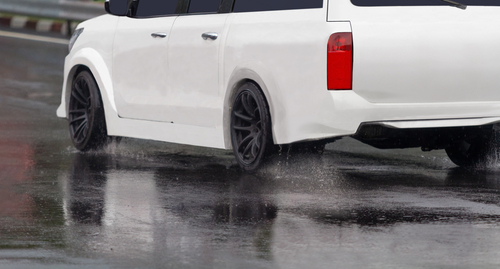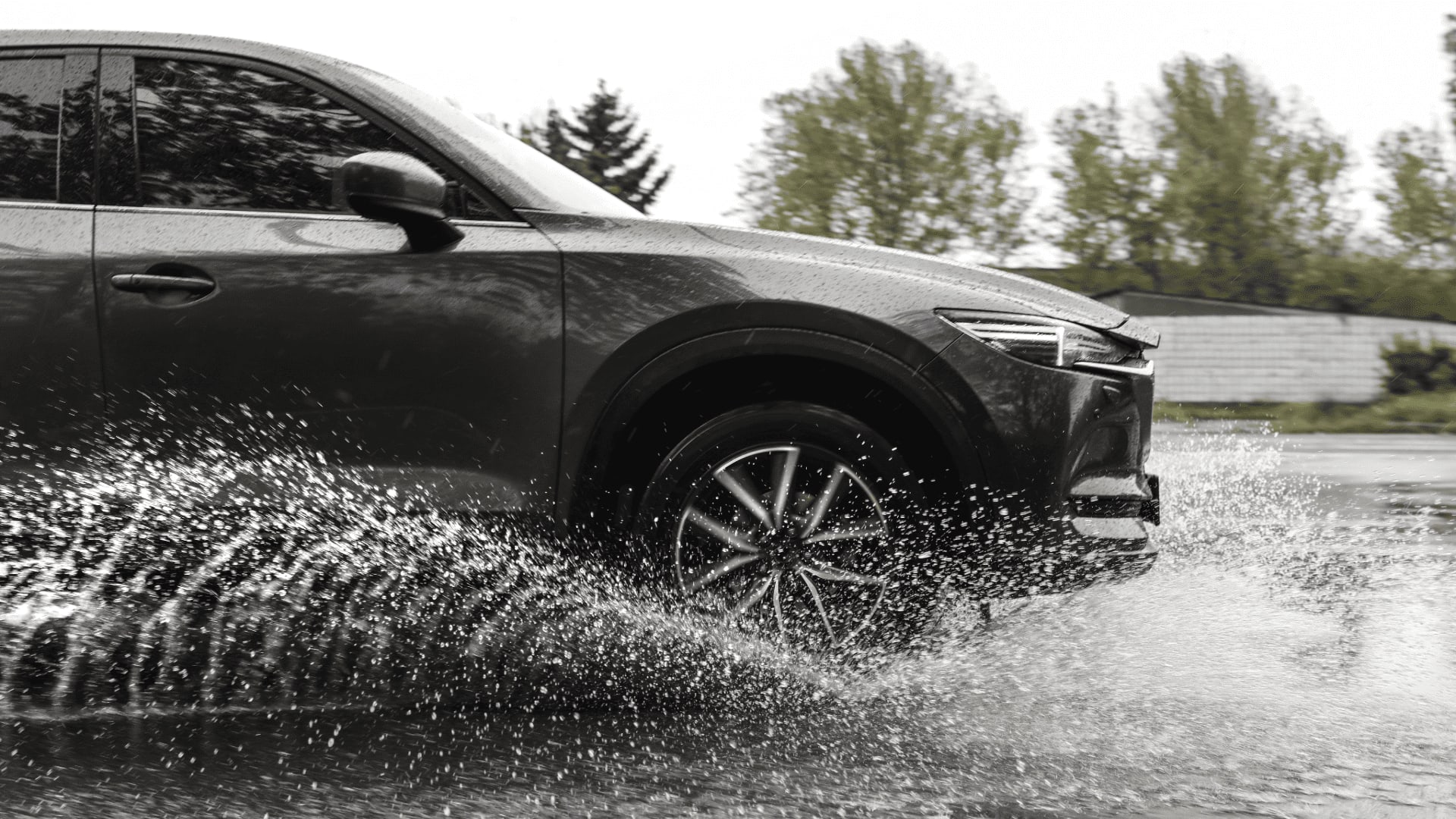Tire maintenance & safety
What is hydroplaning? And how can I prevent it?

Free shipping
Best price guarantee
Special pricing
Financing with Resolve
Easy returns
Tire maintenance & safety


Driving in wet conditions can be challenging, even for the most experienced motorists. One of the most dangerous situations that can occur on rain-soaked roads is hydroplaning—a phenomenon that causes vehicles to lose traction and skid uncontrollably.
Understanding the mechanics of hydroplaning is crucial for staying safe behind the wheel during inclement weather. By learning how it happens and what steps to take to prevent it, drivers can significantly reduce their risk of accidents.
In this article, we'll dive deep into the world of hydroplaning, exploring its causes, effects, and prevention strategies. Armed with this knowledge, you'll be better equipped to handle slick roads and arrive at your destination unscathed.

Hydroplaning occurs when a vehicle's tires encounter more water than they can disperse, causing them to lose contact with the road surface and glide on a thin film of water. This loss of traction results in a significant reduction in steering control, braking effectiveness, and overall vehicle maneuverability.
To understand how hydroplaning happens, it's essential to know how tires function in normal driving conditions. A tire's tread is designed with grooves that channel water away from the contact patch—the area where the tire meets the road. When the tire can effectively disperse water, it maintains a secure grip on the pavement.
However, when the tire encounters more water than it can handle, the water pressure at the front of the wheel forces water under the tire. This creates a wedge of water that lifts the tire off the road surface, causing it to lose traction and hydroplane.
Several factors can increase the likelihood of hydroplaning:
By understanding these contributing factors, drivers can take proactive steps to minimize their risk of hydroplaning. Maintaining proper tire inflation, replacing worn tires, slowing down in wet conditions, and avoiding deep water when possible are all essential strategies for staying safe on slick roads.

Hydroplaning stems from various factors that work together to reduce a tire's ability to maintain contact with the road. Road conditions play a significant role in this process. When roads become wet, poor drainage and increased water depth create ideal conditions for hydroplaning. The intensity of rainfall can overwhelm a tire's ability to channel water away, leading to a loss of traction.
Driving at high speeds reduces the time available for tires to move water aside, which significantly increases the likelihood of losing grip on wet surfaces. This is why maintaining a cautious speed during heavy rain is essential. In addition, the health of your tires is crucial. Tires with insufficient tread depth lack the necessary channels to effectively clear water, making them more vulnerable to skidding on wet surfaces.
The weight of your vehicle also influences hydroplaning potential. Lighter vehicles don't exert as much downward force on the tires, reducing their ability to cut through standing water. The first 10 minutes of a light rain are the most treacherous. During this time, water mixes with oil residue on the road, creating a slick surface that can easily lead to hydroplaning. Understanding these factors can help drivers take preventive measures to ensure safe travels during adverse weather conditions.

Avoiding hydroplaning starts with diligent attention to tire care. Ensuring that your tires have the right air pressure optimizes their performance, allowing them to effectively handle wet conditions. Consistently inspecting your tires for sufficient tread is vital, as this feature is key to maintaining grip and safely channeling water away from the tire surface.
Reducing your speed when roads are wet decreases the likelihood of hydroplaning, offering better handling and stability. The initial moments of rainfall are particularly risky; oils on the pavement mix with water, creating slippery surfaces that demand cautious driving. Steering clear of large puddles or areas with accumulated water is another proactive step to maintain control and prevent skidding.
Selecting a lower gear can improve traction and control, making it easier to navigate through wet roads. It's also beneficial to manually adjust your speed instead of relying on cruise control, which ensures you can respond quickly to changes in road conditions. Extending the distance between your car and others enhances your ability to react to sudden stops or skids. By driving along the paths created by vehicles ahead, you can benefit from a clearer track with reduced water levels.

Navigating a hydroplaning event demands calmness and deliberate actions to regain control effectively. The primary step involves resisting any urge to panic; maintaining a clear head prevents exacerbating the situation. As water lifts your tires off the road, slowly ease off the accelerator to let the vehicle reduce speed naturally. This controlled deceleration helps regain traction without causing abrupt movements that could worsen the skid.
Avoid making sudden, harsh braking actions, as these can lead to further instability. Instead, gently turn the steering wheel in the direction the car is sliding. This maneuver aligns your tires with the path of travel, assisting in re-establishing contact with the road. For vehicles equipped with anti-lock brakes, applying steady pressure allows the system to manage wheel slip and aids in recovering control.
Once traction is restored and you have control, take a moment to evaluate your surroundings. If conditions allow, pull over to a safe spot to regroup and regain composure. This pause offers a chance to reflect on the experience, helping you to be better prepared for future encounters with wet driving conditions.

Choosing the right tires is essential for maximizing safety and performance on wet roads. Tires tailored for rain often come with advanced tread designs and rubber materials that improve their ability to shed water and grip the surface. These features are vital for maintaining control during heavy rainfall or on slippery roads.
When selecting tires for rainy weather, it's important to consider several attributes that enhance their performance. Those with higher speed ratings ensure stable handling and traction at elevated speeds, which is advantageous in stormy conditions or on highways. Additionally, tires crafted specifically for rain include tread patterns optimized for swift water evacuation, helping to mitigate the likelihood of hydroplaning.
To ensure safety in wet weather, regular tire upkeep is crucial. Rotating tires as advised helps achieve uniform wear, which is important for maintaining effective tread depth and functionality. Keeping tire pressure within the manufacturer's recommended levels ensures better traction and handling. With these factors in mind, drivers can approach wet roads with greater assurance.
By understanding the causes of hydroplaning and taking proactive measures to prevent it, you can significantly enhance your safety on wet roads. Remember, investing in quality tires designed for rainy conditions and practicing regular tire maintenance are essential steps in reducing the risk of hydroplaning. When you're ready to find the perfect tires for your vehicle, visit SimpleTire, where we offer a wide selection of top-quality tires at competitive prices, making it easy for you to shop online and stay safe on the road.
Search By